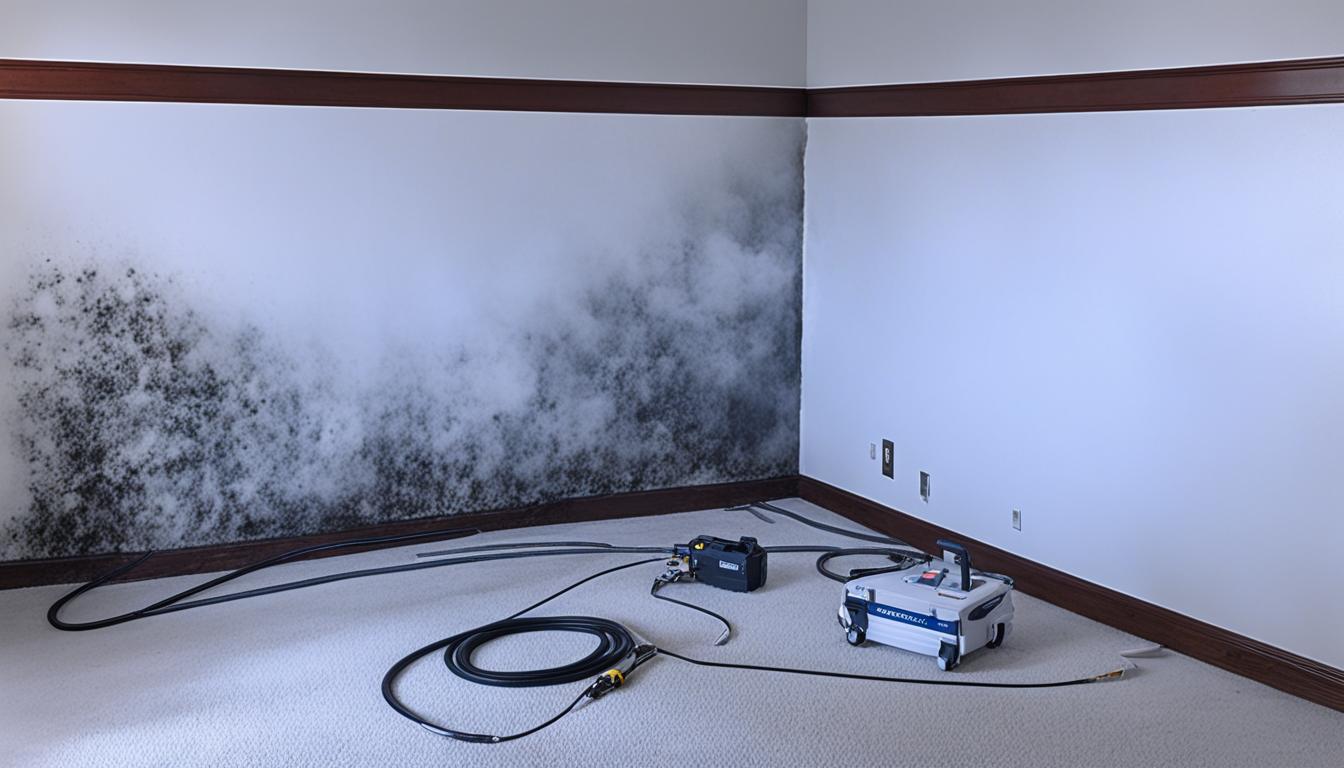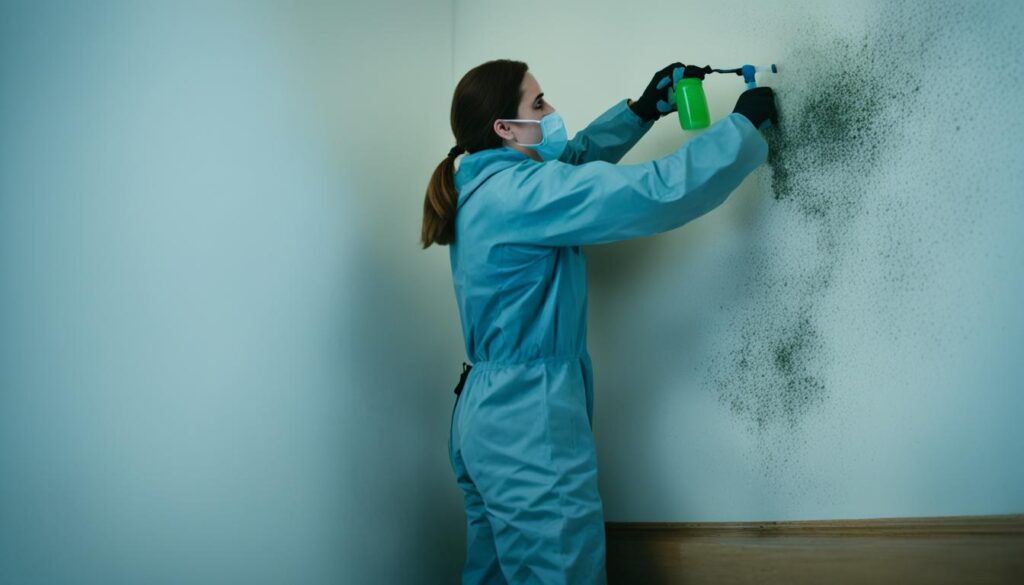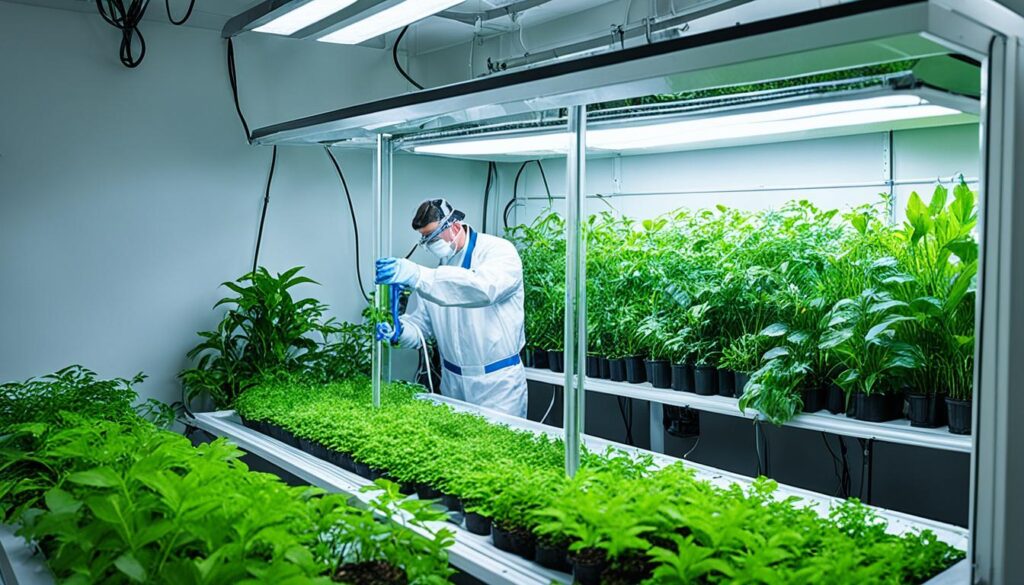
Mold Remediation for Enclosures: Effective Solutions
Welcome to our comprehensive guide on mold remediation for enclosures. In this article, we will explore effective solutions to address mold problems and provide you with actionable steps to protect your health and property. If left untreated, mold growth can not only cause extensive damage to your enclosures but also pose significant health risks. Therefore, it is crucial to understand the causes and impacts of mold in enclosures and take swift action to fix the problem.
Key Takeaways:
- Mold growth in enclosures can lead to property damage and health hazards.
- It is essential to address mold problems promptly and effectively.
- DIY techniques can be used for smaller mold issues in enclosures.
- For severe mold problems or larger enclosures, professional remediation services may be necessary.
- Preventive measures like proper ventilation and controlling humidity levels can help prevent mold growth.
Understanding Mold in Enclosures
Mold can be a persistent and damaging problem in enclosed spaces. Understanding the causes and impacts of mold growth is crucial for effective mold removal, enclosure mold treatment, and fixing mold problems. By recognizing the common signs of mold growth and the potential health hazards associated with it, you can take the necessary steps to address the issue promptly and prevent further damage.
Mold growth is often caused by excess moisture and poor ventilation in enclosed spaces. When moisture levels are elevated, especially in areas with high humidity or water leaks, mold spores thrive and can quickly spread. The presence of mold can not only damage the structural integrity of the enclosure but also pose significant health risks to the occupants.
Common signs of mold growth in enclosures include:
- Visible mold growth on walls, ceilings, or other surfaces
- A musty or damp odor
- Discoloration or staining on surfaces
- Peeling or bubbling paint or wallpaper
- Recurring respiratory issues, allergies, or asthma symptoms in occupants
Mold can release spores into the air, which, when inhaled, can cause respiratory problems, allergies, and other health issues. This is why it is crucial to address mold problems promptly, perform mold removal, and implement proper enclosure mold treatment to ensure a healthy and safe environment for occupants.
Maintaining proper enclosure maintenance is key to preventing mold growth. Regular inspections to identify and address any sources of moisture, such as leaks or condensation, are essential. Ensuring proper ventilation and controlling humidity levels can also help prevent mold from taking hold and spreading.
“Prompt action is necessary when mold growth is detected to prevent further damage and mitigate health risks. By understanding the causes and impacts of mold in enclosures, you can take the necessary steps to address the issue effectively.”
By understanding mold in enclosures, you can better comprehend the importance of mold removal, proper enclosure mold treatment, and fixing mold problems. To further explore effective solutions, let’s delve into the DIY mold removal techniques that can be implemented in section 3.
Potential Health Hazards of Mold in Enclosures
| Health Hazard | Impact |
|---|---|
| Allergies | Allergic reactions, such as sneezing, coughing, and skin irritation |
| Asthma Aggravation | Increased frequency and severity of asthma symptoms |
| Respiratory Infections | Higher risk of respiratory infections due to compromised immune system |
| Chronic Fatigue | Feeling exhausted or tired due to ongoing exposure to mold |
| Toxic Reactions | Severe reactions in individuals sensitive to mycotoxins released by certain molds |
DIY Mold Removal Techniques
Mold removal is a critical task that should be addressed promptly to prevent further damage and potential health risks. While hiring professional mold remediation services is advisable for severe cases, there are also DIY techniques you can employ to tackle mold in enclosures on your own.
Before you begin the mold removal process, it is essential to gather the necessary tools and equipment. Here are some items you’ll need:
- Protective gloves
- N95 respirator mask
- Goggles
- Disposable coveralls
- Scrub brush
- Bleach or a mold-specific cleaner
- Plastic sheets or tarps
- Trash bags for disposing of contaminated materials
- Adequate ventilation
Once you have the tools ready, follow these step-by-step instructions to effectively remove mold in confined spaces:
- Assess the extent of the mold: Carefully inspect the enclosure for visible mold growth. Pay attention to areas with high humidity or previous water damage.
- Prepare the workspace: Cover the surrounding area with plastic sheets or tarps to prevent mold spores from spreading. Open windows or use fans to ensure proper ventilation.
- Protect yourself: Put on protective gloves, an N95 respirator mask, goggles, and disposable coveralls to minimize your exposure to mold spores.
- Scrub the moldy surface: Use a scrub brush and a mold-specific cleaner or a mixture of bleach and water (1 part bleach to 10 parts water) to scrub the moldy surface thoroughly. Focus on removing all visible mold and staining.
- Dispose of contaminated materials: Place all contaminated materials, including the scrub brush and cleaning cloths, into sealed trash bags. Double bag the materials to prevent mold spores from escaping.
- Thoroughly clean the area: After removing the mold, clean the area with a damp cloth to remove any remaining mold debris. Dispose of the cloth in a sealed trash bag.
- Dry the area and monitor for mold: Ensure that the area is completely dry to prevent future mold growth. Monitor the space regularly for any signs of mold reappearing.
Remember, when dealing with mold, safety should always be a priority. If you have any doubts or if the mold problem is extensive, it is best to consult with a professional mold remediation service.

Professional Mold Removal Services
When it comes to dealing with severe mold issues or larger enclosures, hiring professional mold removal services is a wise decision. These experts possess the knowledge, experience, and specialized equipment necessary to effectively identify and eliminate all traces of mold, ensuring a safe and mold-free environment.
One of the key advantages of opting for professional mold remediation is the expertise these professionals bring to the task. They have a deep understanding of mold growth patterns, the different types of mold, and the most effective techniques to tackle each specific situation. By leveraging their knowledge, they can efficiently address your mold problem and provide long-lasting results.
“Professional mold removal services have the expertise, specialized equipment, and techniques to effectively identify and eliminate all traces of mold.”
Furthermore, professional mold remediation services utilize advanced mold cleanup techniques that go beyond what can be achieved through DIY methods. They have access to state-of-the-art equipment and technologies that enable them to thoroughly clean and treat affected areas, ensuring that the mold is completely eradicated.
By hiring professionals, you can also save time and effort. Mold cleanup can be a complex and time-consuming process, especially in larger enclosures. Professional mold removal services have the necessary manpower and resources to efficiently complete the task, allowing you to focus on other priorities.
Benefits of Professional Mold Removal Services:
- Expertise in identifying and eliminating all traces of mold
- Access to advanced mold cleanup techniques and equipment
- Efficient and thorough cleaning of affected areas
- Saves time and effort
When hiring professional mold removal services, ensure that you choose a reputable and certified provider. Look for companies that have a track record of success in mold remediation and positive customer reviews. This way, you can have confidence in their ability to effectively resolve your mold issues.
| Benefits of Professional Mold Removal Services |
|---|
| Expertise in identifying and eliminating all traces of mold |
| Access to advanced mold cleanup techniques and equipment |
| Efficient and thorough cleaning of affected areas |
| Saves time and effort |
By entrusting your mold remediation needs to professionals, you can have peace of mind knowing that your enclosure will be thoroughly cleaned and restored to a safe and mold-free state.
Preventing Mold Growth in Enclosures
Mold growth in enclosures can be a persistent problem if not properly addressed. Taking preventive measures is essential to avoid future mold issues. By following these practical tips, you can effectively prevent mold growth in your enclosures:
- Maintain Proper Ventilation: Adequate airflow is crucial in preventing mold growth. Ensure that your enclosures have proper ventilation systems to promote air circulation. Consider installing exhaust fans or dehumidifiers in areas prone to high humidity.
- Control Humidity Levels: Excess humidity creates an ideal environment for mold to thrive. Keep indoor humidity levels below 60% by using air conditioners or dehumidifiers. Consider using moisture-absorbent materials like silica gel packets in enclosed spaces.
- Promptly Address Leaks and Moisture Issues: Any leaks or moisture issues should be addressed promptly to prevent mold growth. Regularly inspect your enclosures for signs of water damage or leaks, such as damp walls, ceilings, or floors. Repair any leaks and address moisture problems immediately.
- Create a Cleaning Routine: Regular cleaning and maintenance play a crucial role in mold prevention. Vacuum and dust enclosures regularly to remove any mold spores that may have settled. Clean surfaces with mold-inhibiting solutions, and ensure that all materials and equipment are kept dry to discourage mold growth.
- Perform Regular Inspections: Regular inspections can help you detect and address any potential mold problems early on. Check for any signs of mold growth, such as musty odors, discoloration, or visible mold patches. Address any issues promptly to prevent further spread.
By implementing these preventive measures, you can effectively minimize the risk of mold growth in your enclosures, ensuring a healthier and safer environment.

Effective Strategies for Mold Remediation
In order to successfully remediate mold in enclosures, it is crucial to employ effective strategies that address the root causes and eliminate the mold growth effectively. While DIY techniques and professional mold remediation services are commonly employed, there are more advanced methods available that can provide highly efficient results.
One effective technique is dry ice blasting, which involves the use of pressurized carbon dioxide (dry ice) to remove mold. The dry ice pellets are propelled onto the affected surfaces, freezing the mold and causing it to become brittle. As the dry ice evaporates, it pulls the frozen mold away, effectively removing it from the enclosure.
Another efficient method is ozone treatment. Ozone is a powerful oxidizing agent that can neutralize mold spores and eliminate musty odors. Ozone generators are used to release ozone gas into the enclosure, where it penetrates hard-to-reach areas and destroys mold at the molecular level. It is important to note that ozone treatment should be performed by professionals, as ozone is toxic and requires proper containment and ventilation.
Additionally, the application of antimicrobial coatings can help prevent future mold growth and inhibit the spread of existing mold. These coatings contain special additives that actively kill mold spores and prevent them from proliferating. They can be applied to surfaces such as walls, ceilings, and ductwork to provide long-lasting protection against mold infestation.
Advanced mold remediation techniques such as dry ice blasting, ozone treatment, and antimicrobial coatings can offer highly effective solutions for removing mold in enclosures. These methods go beyond traditional cleaning approaches and provide more thorough and long-lasting results.
It is important to consider the advantages and limitations of each technique when choosing the most suitable strategy for mold remediation. Dry ice blasting is highly effective in removing mold from various surfaces, but it may not be suitable for delicate materials. Ozone treatment, while powerful in eliminating mold, requires careful handling and professional expertise. Antimicrobial coatings, on the other hand, provide ongoing protection against mold growth but may require reapplication over time.
By utilizing these advanced techniques, mold remediation professionals can efficiently eliminate mold and restore the integrity of enclosures. However, it is essential to assess the extent of the mold problem and consult with experts to determine the best course of action. Taking proactive measures and investing in effective mold removal strategies can help prevent further damage and ensure a healthy living environment.
| Technique | Advantages | Limitations |
|---|---|---|
| Dry Ice Blasting | – Removes mold from various surfaces – Non-toxic and environmentally friendly – Does not generate additional waste |
– May not be suitable for delicate materials |
| Ozone Treatment | – Neutralizes mold spores and eliminates odors – Reaches hard-to-access areas – Provides long-lasting results |
– Requires professional handling – Ozone is toxic and requires proper containment |
| Antimicrobial Coatings | – Prevents future mold growth – Inhibits the spread of existing mold – Long-lasting protection |
– May require reapplication over time |
Conclusion
In conclusion, mold remediation is a crucial step in maintaining the safety and integrity of enclosures. Whether you choose to tackle the issue yourself or seek professional assistance, it is important to take immediate action when mold problems arise.
By following the DIY techniques discussed in this article, you can effectively remove mold from smaller enclosures and prevent further damage. However, for more severe cases or larger enclosures, it is advisable to hire professional mold remediation services. Their expertise and specialized equipment ensure a thorough and effective removal of mold.
Additionally, preventive measures play a vital role in mold prevention. By practicing regular maintenance, addressing leaks and moisture issues promptly, and maintaining proper ventilation, you can significantly reduce the risk of mold growth in your enclosures.
Remember, mold can pose serious health risks, as well as cause structural damage. Therefore, it is crucial to be proactive in addressing and preventing mold issues in enclosures. With the right approach and a combination of DIY techniques and professional services, you can ensure a safe and mold-free environment for yourself and your loved ones.




